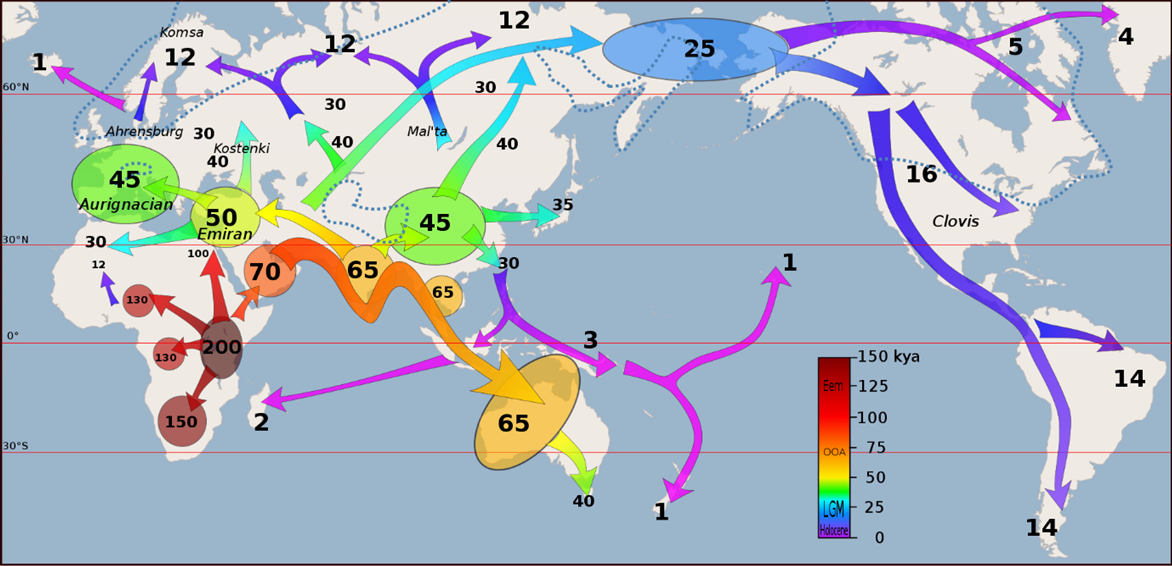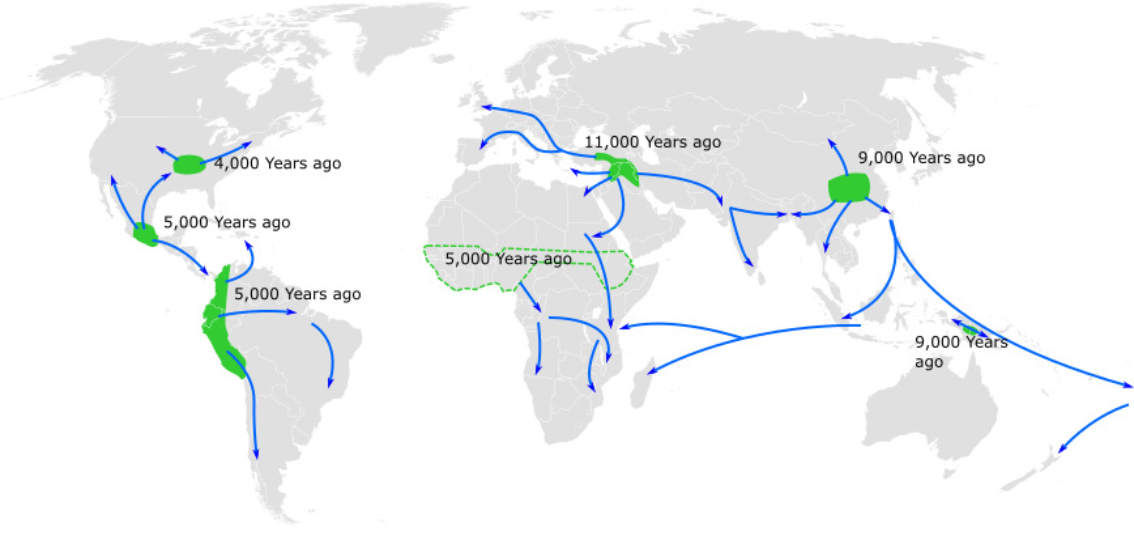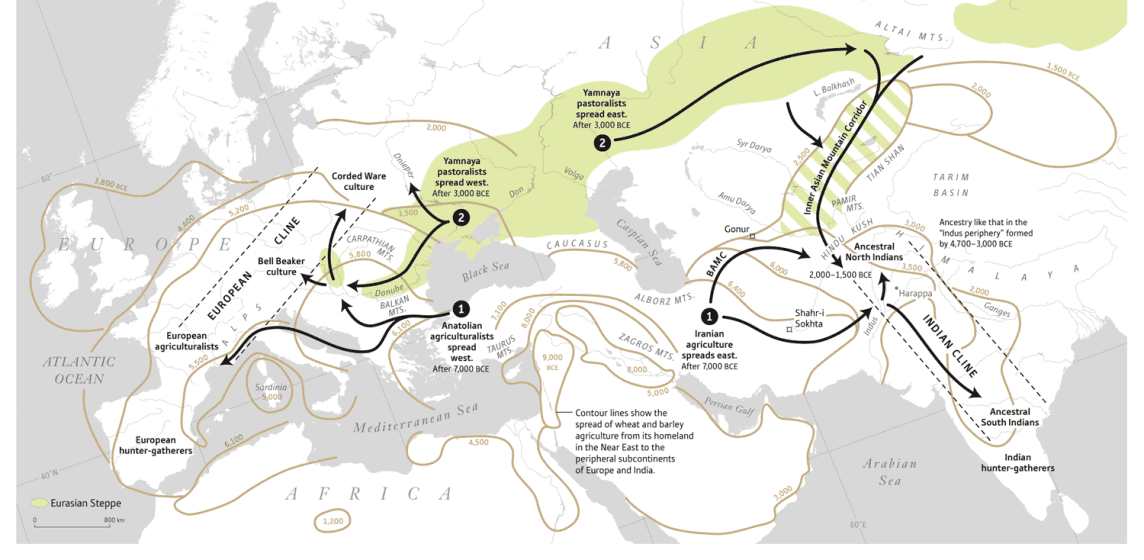Dr Saad Saleem Arif
Introduction
This study investigates the story of humans
from early hominid origins to the so-called “Human Era.” It
posits that modern humans, i.e. Prophet Adam’s descendants,
merged with or supplanted other contemporaneous anatomically
similar human populations. This hypothesis is supported by an
interdisciplinary approach that includes religious texts, such
as the Bible and the Quran, alongside scientific disciplines.
The paper presents diverse findings to construct a coherent
narrative on transitioning from hominids to modern humans.
The Emergence of Early Modern Humans
Fossil evidence indicates that anatomically
modern humans (Homo sapiens) first appeared in Africa around
200,000 to 300,000 years ago. Over time, these early humans
migrated globally, developing tools and surviving in various
environments (see Figure 1). For instance, humans left Africa
about 70,000 years ago and reached Central Asia around 40,000
years ago (Higham et al., 2014).

Figure 1: Migration of humans - when did
humans arrive first at any given place on Earth (scale for
time is in thousands of years)
Coexistence of Early Modern Humans with
Other Hominid Species
Early modern humans coexisted with other
hominid species, such as Neanderthals and Denisovans, for
thousands of years. Archaeological evidence shows these groups
interacted, competed, and interbred, contributing to modern
human genetic diversity (Prüfer et al., 2014). Neanderthals
and Denisovans disappeared from the fossil record around
40,000 years ago, likely due to competition with early modern
humans and environmental changes.
Cultural Characteristics of Early Modern
Humans
Anatomically akin to present-day humans,
early modern humans demonstrated characteristics that are
fundamental to our natural instincts and behaviours today:
● Communications Skills. Historical
records and archaeological findings suggest complex
communication abilities, such as symbolic cave paintings at
sites like Lascaux (France) and Altamira (Spain).
● Propensity to violence. Evidence
of skeletal trauma and weapon-inflicted injuries reveals early
humans' capacity for violence, likely related to conflicts
over resources or territory (Walker, 2001).
● Clothing and tools. Genetic
studies on lice suggest clothing was adopted around 170,000
years ago, coinciding with human migration patterns (Toups et
al., 2011). The use of clothes for protection and social
purposes in the Palaeolithic era is evidenced by the discovery
of bone tools believed to have been used for making clothing
(Gilligan, 2010). Levalloisian stone-flaking technique for
producing stone tools demonstrates a sophisticated
understanding of geometry.
● Burial rituals. Intentional
burials with grave goods suggest that early humans practised
rituals (Pearson, 1999).
● Diet. Stable isotope analysis
indicates a diet primarily composed of meat from large
ruminants, with mammoths being a significant prey species
(Richards & Trinkaus, 2019) (see Figure 2).

Figure 2: Relative proportions (in %) of
different prey species to the protein intake calculations
based on δ13C and δ15N isotope analysis from two sites. Taken
from (Richards & Trinkaus, 2019)
Commencement of the ‘Human Era’
About 12,000 years ago, the agricultural
revolution began, fundamentally altering human society. With
the advent of farming, humans developed stable communities,
culminating in the first known cities. The city of Jericho is
often considered the first known city, built around 9,000 BCE
in the Levant region and Çatalhöyük in modern-day Turkey is
regarded as one of the earliest urban settlements, existing
from approximately 7100 BC to 5700 BC (Meece, 2006). Around
12,000 years ago, this period corresponded with the religious
narratives of Adam, who was considered the first true human
whose descendants developed agriculture and animal farming
(Genesis 4:2).
This alignment is also indicated in Surah
Baqarah of the Quran. God elevated humans to the status of “Khalifa,”
or stewards of Earth (Quran 2:30). Angels questioned this
promotion, referencing humans' tendency towards mischief and
bloodshed, an observation possible only if humans had already
existed on Earth before Prophet Adam. In summary, Prophet
Adam’s arrival signifies the handing over of the world’s
stewardship to Adam’s progeny. This promotion resulted in the
sudden employment of various technologies and humans’
extensive exploitation of the earth’s resources around 12,000
years ago.
This new era for humans is also called the
Human Era or the Holocene Era, and it started with the
Neolithic Revolution.
Prophet Adam’s Descendants and Other Humans
There were anatomically similar human
beings
before Prophet Adam, and he probably coexisted with them. The
survival of Prophet Adam's descendants can be attributed to
the spirit blown into Adam, as mentioned in the Qur’a#n 38:72
and the knowledge God gave to Adam and his progeny for
agriculture, animal farming, as mentioned in Genesis 4:2, and
a fully functional language. Other human populations may have
perished due to environmental changes, assimilated through
intermarriage with Prophet Adam’s progeny and some killed by
Prophet Adam’s progeny.
For example, Neolithic Europe experienced
significant genetic diversity changes due to population
replacements and expansions, primarily from the Levant. These
movements led to substantial genetic admixture with existing
European populations, often involving partial or complete
replacement of local populations (Smith & Ahern, 2013).
However, this migration from Lavant has not been uniform to
other hunter-gatherer populations across the globe. The
dispersal of agriculture from the Lavant region exhibits a
parallel pattern. Figure 3 shows the spread of farming from
Lavant dating back to 9,000 BCE, while farming in other world
regions appeared later in history.

Figure 3: Spread of farming
Migrations after the Great Flood
A significant event of the Great Flood
occurred, which, according to the Bible
and Quran,
came as a punishment to Prophet Noah’s nation. Following the
Great Flood, the descendants of Prophet Noah's sons—Ham, Shem,
and Japheth—initially settled in Africa, the Middle East and
Central Asia, respectively.
Subsequently, their progenies migrated to neighbouring
regions. Figure 4 shows these migratory patterns in terms of
geospatial and temporal dispersions. For example, we see a
pattern of Iranian farmers’ migration to Northwestern parts of
India, possibly from Shem’s children, much earlier than the
later migration of Central Asian pastorals to India, possibly
from Japheth’s children.

Figure 4: The prehistory of South Asia and
Europe are parallel in both being impacted by two successive
spreads, the first from the Near East after 7000 BCE bringing
agriculturalists who mixed with local hunter-gatherers, and
the second from the Steppe after 3000 BCE bringing people who
spoke Indo-European languages and who mixed with those, they
encountered during their migratory movement
Age of Abrahamic Prophets
Around 2000 BCE, the age of Abrahamic
prophets commenced. During this period, God’s judgement on a
select group of people, which became proof of God’s Judgment
for other nations, was primarily restricted to Abraham’s
progeny, notably with the rise and fall of the Israelites. The
Israelites experienced cycles of prosperity and decline,
reflecting their relationship with God. After Prophet Jesus,
the Israelites lost sovereignty, and the Ishmaelites rose to
prominence with Prophet Muhammad about 1400 years ago.
Ishmaelites experienced rise and fall cycles similar to
Israelites (Saleem, 2008).
Conclusion
Human history can be understood through a
multidisciplinary approach combining fossil evidence, genetic
analysis, isotopic data, archaeological findings, and
religious texts. This synthesis provides a comprehensive view
of human origins and development.
References
Gilligan, I. (2010). The prehistoric
development of clothing: Archaeological implications of a
thermal model. Journal of Archaeological Method and Theory,
17(1), 15–80.
https://doi.org/10.1007/s10816-009-9076-x
Higham, T., et al. (2014). Timing and
spacetime patterning of Neanderthal extinction. Nature,
512(7514), 306–309.
Meece, S. K. (2006). A bird’s eye view of
Çatalhöyük. Anatolian Studies, 56, 1–21.
Pearson, M. P. (1999). The archaeology of
death and burial. Sutton Publishing.
Prüfer, K., et al. (2014). The complete
genome sequence of a Neanderthal from the Altai Mountains.
Nature, 505(7481), 43-49.
Richards, M. P., & Trinkaus, E. (2019).
Stable isotopes reveal patterns of diet and mobility in the
last Neandertals and first modern humans in Europe. Scientific
Reports, 9(1), March 2019.
Saleem, M. S. (2008). Shahadah: Witnessing
of the Truth. Renaissance – A Monthly Islamic Journal.
http://www.monthly-renaissance.com/issue/content.aspx?id=713
Smith, F. H., & Ahern, J. C. M. (Eds.).
(2013). The Origins of Modern Humans: Biology Reconsidered.
Hoboken, NJ: John Wiley & Sons.
Toups, M. A., Kitchen, A., Light, J. E., &
Reed, D. L. (2011). Origin of clothing lice indicates early
clothing use by anatomically modern humans in Africa.
Molecular Biology and Evolution, 28(1), 29–32.
https://doi.org/10.1093/molbev/msq234
Walker, P. L. (2001). A bioarchaeological
perspective on the history of violence. Annual Review of
Anthropology, 30(1), 573–596.
____________
|